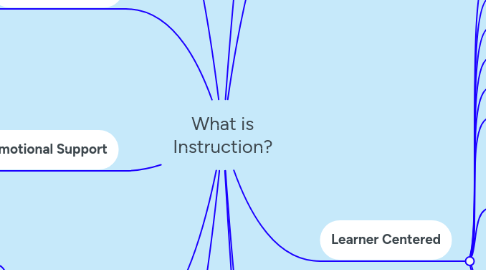What is Instruction?
Erica Holleyにより


1. Class Room Culture
1.1. Syllabus
1.2. Expectations
1.3. Behavioral Incentives
1.4. Relationship Building
1.5. Disciple-Management Powers
1.5.1. expert powr
1.5.2. reward power
1.5.3. legitimate power
1.5.4. coercive power
1.5.5. attractive power
2. Stages of Instruction
2.1. Orientation: Introduction
2.2. Presentation: Explaining New Material
2.3. Structured Practice: Teacher led
2.4. Guided Practice: Teacher assisted
2.5. Independent Practice: students practice on their own
3. Methods of Instruction
3.1. Direct Instruction
3.2. Cooperative Learning
3.3. Differentiated Instruction
3.4. Lecture
3.5. Project Based
3.6. Independent Study
4. Teacher Centered
4.1. Planning
4.2. Professional Development
4.3. Observations
4.4. Reflection
4.5. Feedback
5. Learner Centered
5.1. Student Choice
5.2. Social/Emotional Wellbeing
5.3. Interests
5.4. 504 and IEP
5.5. Feedback
5.6. Reflection
5.7. LCI
5.7.1. Humanistic
5.7.2. constructivist
5.7.3. care
5.7.4. brain-based
5.7.5. critical pedagogies
5.8. Engagement
5.8.1. Participation
5.8.2. Class Discussion
5.8.3. Small Group
5.8.4. Self-Directed
5.8.5. Intrinsict Motivation
5.8.6. Cooperative Social Connections
5.9. Executive Functions
5.9.1. metacongive thinking
5.9.2. autonomy
5.9.3. self-regulation
6. Social Emotional Support
6.1. Setting goals
6.2. Exhibit empathy
6.3. Conflict resolution
6.4. Communication
6.5. Reflection
7. Facilitation
7.1. Warmth
7.2. Trust: Optimism and High Expectations
7.3. Empathy: Getting to know Students
7.4. Realness: Honestly
7.5. Positive Relationships
8. Achievment
8.1. Standardized test scores
8.2. aptitude
8.3. Grades
8.4. high stakes
8.5. traditional regulated education
9. Learning
9.1. authentic
9.2. wholetheme achievement
9.3. real life settings
9.4. showcase what students can do
10. Backward Design
10.1. 1) Identify Results/desired outcomes
10.1.1. Big Ideas/skills
10.2. 2) Acceptable levels of evidence
10.2.1. culiminating assessmesnts and tasks
10.3. 3) design acitivites that will make desired results happen
10.3.1. Learning events

